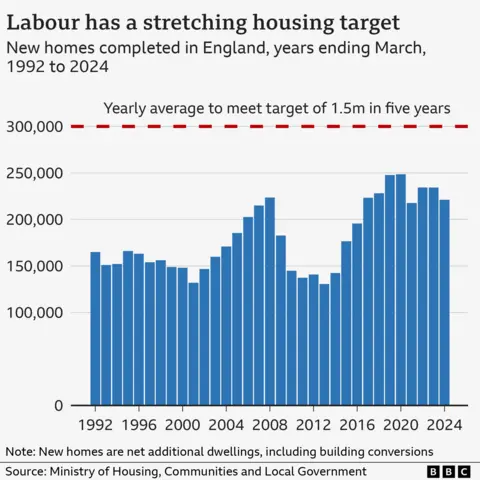BBC Verify
 BBC
BBCSome local councils in England would need to see at least a five-fold increase in new housing to meet government targets, analysis by BBC Verify suggests.
The BBC’s figures lay out the immense challenge Labour has set itself in government with its “milestone” of building 1.5 million new homes in England over five years.
In total, 16 local authorities across England have new annual targets that are 400% or more what they have recently delivered.
Prime Minister Sir Keir Starmer has said setting a specific target will “give the British people the power to hold our feet to the fire”.
With that in mind, the BBC has created a new online tool for tracking the government’s progress towards this key goal.
Type in your postcode and see the house building situation in your own area.
The government has also set annual housing targets for each local authority in England, based on what it judges their contribution to the overall total should be.
The most demanding target is for the London Borough of Kensington and Chelsea, which has been set a target for new homes nearly 22 times its recent average.
The target for Sevenoaks in Kent is five times what it has been delivering on average in recent years, while the target for Portsmouth is more than eight times the average.
These specific targets will enable us to incorporate information into the tracker on what’s happening on house building in every district in England.
It will show the number of homes added in an area and compare it with the local target set by ministers.
Our postcode lookup tool also shows the share of planning applications for new homes granted permissions in an area in the most recent year there is data for, and compares it with the England-wide average rate, so you can judge whether your council is approving enough building plans.
The tracker will be updated when relevant official data becomes available.
The new government has described its housebuilding objective as “hugely ambitious” and that is no exaggeration.
To deliver 1.5 million homes, defined as “net additional dwellings”, over five years implies a strike rate of about 300,000 a year – a number not achieved since the 1970s.

But while the England-wide target is highly ambitious in a historical context, the targets handed down to some local authorities are arguably even more so.
To create our postcode tracker we processed local data on:
- the number of annual net additional dwellings required
- the number of net additional dwellings created on average each year since 2021
- recent residential planning decisions by councils.
BBC Verify’s analysis shows Kensington and Chelsea, a London borough, has been given a target of 5,107 new homes every year for the next five years. But the borough delivered an average of only 236 net additional dwellings between 2021-22 and 2023-24.
It did, however, approve 89% of planning applications for housing in the year to June 2024, considerably higher than the national rate of 71%.
Portsmouth, on the south coast, also has a very stretching target. The local council is being asked to deliver 1,021 new homes per year, almost nine times the 120 it delivered on average over the most recent three years.
Hastings has been tasked with a smaller total: 710. But this is still five times the 142 it has delivered on average in recent years.
Portsmouth approved 74% of residential planning applications in the year to June 2024 and Hastings 75%.
Councils were consulted on the targets last summer, with many expressing concerns they were “unrealistic”, and the numbers were revised.
Councillor Elizabeth Campbell, leader of Kensington and Chelsea, said it was “out of touch to let algorithms set targets without understanding local context”.
“You only have to walk through the streets of our densely built borough to see how unachievable it would be to build 5,107 homes a year here; this borough is only 4.5 miles squared.”
She said there were two major sites in the borough that would provide 6,000 new homes in total.
Councillor Darren Sanders, cabinet member for housing at Portsmouth City Council, said the target “does not work” because “most of the city is an island” with a dense population and “important heritage and natural assets”.
“Portsmouth has approved more than 4,000 new homes in 2023 and 2024. Any lack of delivery is down to the rising cost of development,” he said, “not whether the council approves them.”
Sevenoaks councillor Julia Thornton said it was a “top priority” to protect greenbelt land, but added: “We will have a duty to do everything possible to meet the government’s new housing targets.”
Sir Keir’s housing minister, Matthew Pennycook, has said if councils fail to deliver enough houses the government could intervene.
“The government can take a local plan off a local authority that is resisting putting one in place, and we are absolutely willing to do it, if we have evidence that [they] are refusing to comply,” he told the BBC.
The obstacles
The government said it had “inherited the worst housing crisis in living memory” and “all areas must play their part”.
It has set out “a major planning overhaul… unblocking barriers to building, and setting out targets for councils to ramp up housebuilding, so new homes are built where they are most needed.”
Most housing experts agree planning reform is necessary.
Yet analysts say it is not the only obstacle.
The construction industry has warned it is dealing with a chronic shortage of skilled workers.
The Home Builders Federation has cited aging workers and Brexit as some of the factors behind shortages.
The Construction Industry Training Board estimates the sector needs to attract the equivalent of 50,300 extra workers per year to meet the levels of work expected.
There are also concerns about the availability of basic building materials including bricks and timber.
The Construction Leadership Council has warned a shortage of these could hinder the government’s ability to get near its target.
Finally, many housing experts doubt private housebuilders are capable of delivering enough new homes each year to reach the targets.
This is because private housebuilders have a commercial interest in not building so many new homes that their average price declines.
The Competition and Markets Authority concluded in February 2024 “private developers produce houses at a rate at which they can be sold without needing to reduce their prices”.
A sharp decline in residential planning permissions in England in the year to June 2024 – hitting a new record low – was due to a collapse in applications from private builders, not a decline in the share of applications being approved by local authorities.
This collapse in applications probably reflected the impact of still-high mortgage interest rates and high house prices relative to average incomes, undermining the ability of people to afford newly built houses.
That’s why some argue meeting the government’s targets will also require a major increase in Whitehall grants to not-for-profit local housing associations, enabling them to build tens of thousands of new social and affordable homes, mainly to be rented out, in the coming years.
Interactive tool developed by Allison Shultes, Scott Jarvis and Steven Connor
About the data
Annual data on new homes for England comes from the government’s “net additional dwellings” statistics.
These figures are estimates of changes in the total number of homes in each area, taking account of new build homes and existing building conversions, minus any demolitions.
The targets are the government’s new “local housing need” calculations, released following a public consultation.
Planning statistics are taken from quarterly data and combine applications decided for “minor” housing developments (fewer than 10 homes) and “major” schemes (10 homes or more).
The planning data for England is at local authority level. Applications decided by special authorities, such as those in charge of national parks, are not included.
We have included the latest data on new housebuilding “completions” by local authority area for Wales, Scotland and Northern Ireland, but the 1.5 million homes target applies only in England.




